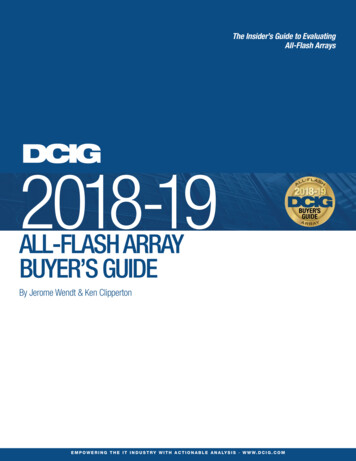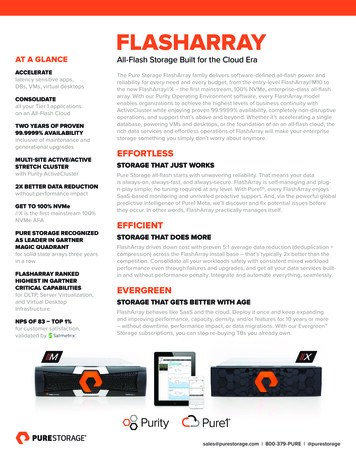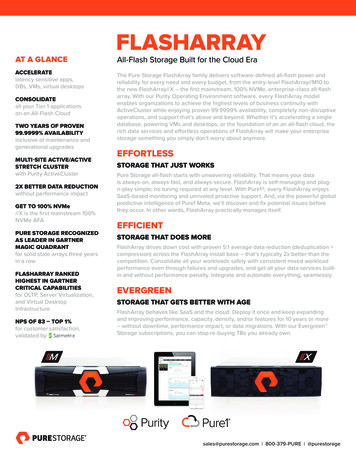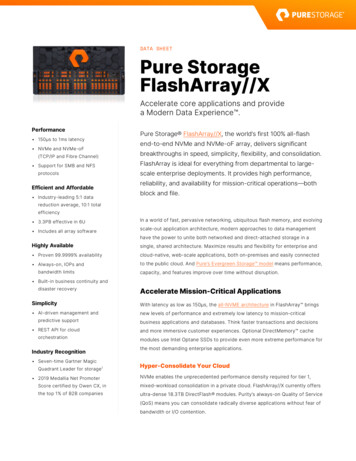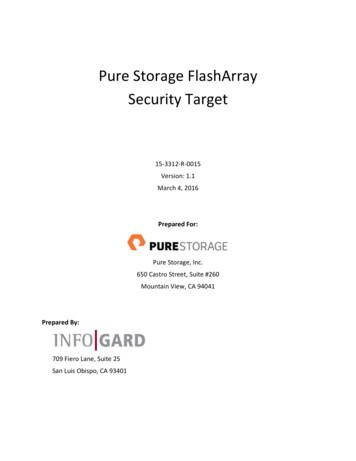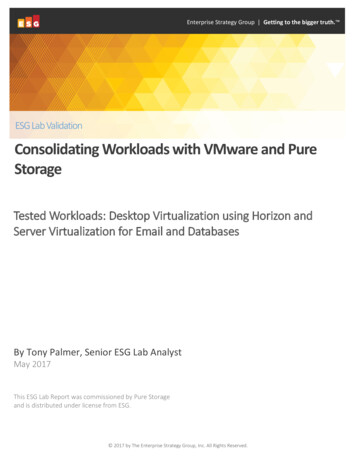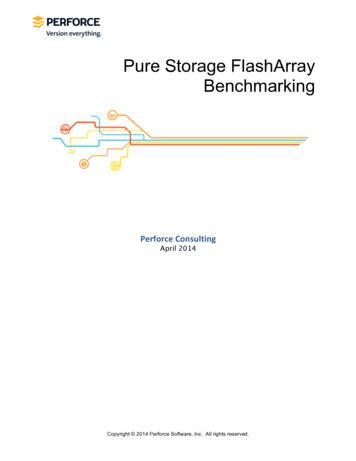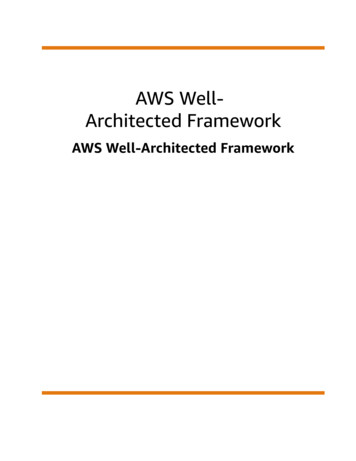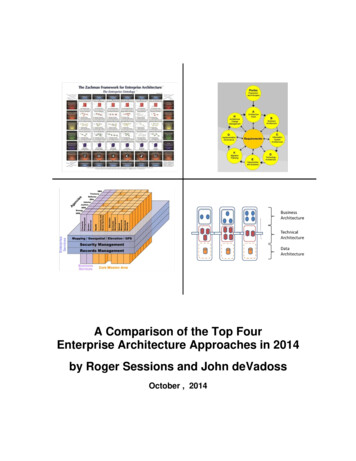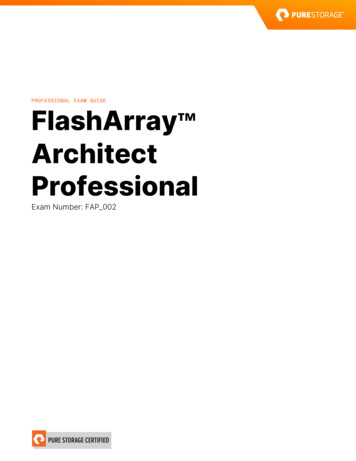
Transcription
PROFESSIONAL EXAM GUIDEFlashArray ArchitectProfessionalExam Number: FAP 002
PROFESSIONAL EXAM GUIDEContentsAbout Pure Storage Certified Exams .3Section 1: Exam Registration Instructions . 41.1. Exam Information .41.2. Creating an Online Account .41.3. Online Exam Computer Requirements .41.4. Day of the Exam .51.5. Exam Scoring .51.6. After the Exam .51.7. Your Candidate Record .6Section 2: Pure Storage FlashArray Architect Professional Exam Topics . 72.1. Domain Names . 72.2. Task Information . 72.3. Domain Distribution.8Section 3: The Pure Storage FlashArray Architect Professional Job Role .93.1. The Minimally Qualified Candidate (MQC).93.2. MQC Work Experience.9Section 4: Determine Exam Readiness . 104.1. Exam Prerequisites . 104.2. On-the-Job Experience . 104.3. Self-Assessment Preparation Worksheet . 10Section 5: Pure Storage FlashArray Architect Professional Exam Sample Questions . 12Section 6: Answer Key . 15Support . 182
PROFESSIONAL EXAM GUIDEAbout Pure Storage Certified ExamsTo be a Pure Storage Certified FlashArray Architect Professional is to demonstrate expertise indelivering fast and reliable solutions that unlock business value and eliminate deployment risk. PureStorage’s Certification exams have been developed following industry best practices to strive forreliable and valid test score interpretations.This guide has two purposes: to provide you with the recommended preparations for the Pure Storage FlashArray Architect Professional Exam, and to help you determine if you are ready to sit for the exam.This guide outlines the knowledge, skills, and abilities required of a “minimally qualified candidate” fora specific job role, which will be evaluated in the exam.3
PROFESSIONAL EXAM GUIDESection 1: Exam Registration Instructions1.1. Exam Information Exam name: Pure Storage FlashArray Architect Professional Exam number: FAP 002 Exam cost: 129 (US Dollars) Number of questions: 75 Question types: Multiple Choice (four or five options; one, two, or three correct answers) Time limit: 120 minutes1.2. Creating an Online Account1. Go to the ExamStudio Storefront.2. Select “Pure Storage FlashArray Architect Professional”.3. Either confirm the scheduling process or log in. The system will automatically recognize if you are eligible and will allow youto move forward.4. Log in to your candidate dashboard and click “Schedule” under the Actions tab.5. Select the appropriate time zone; then, select the date and time you want to take the exam. Please note that exams requirea 24-hour lead time to schedule. The earliest date on which you can make a reservation is the next business day.6. Complete a technical compatibility check by visiting https://go.proctoru.com/testitout1.3. Online Exam Computer RequirementsYour computer must meet the minimum requirements of ProctorU, including: A stable broadband internet service with a download speed of at least 12Mbps down and 3Mbps up Chrome or Firefox web browser. Download ProctorU extensions: Chrome or Firefox Webcam MicrophoneTo check if your computer meets the minimum requirements of the exam provider, visit https://go.proctoru.com/testitout. Towatch a video on how ProctorU works, please click here.You will be prompted to download and run a LogMeIn Rescue applet file that will bring up a chat box to allow you to text withyour proctor. If prompted, be sure to click “Open” or “Allow” to give the file permission to run. When the chat box says“Waiting,” it means that you are in the queue waiting for your proctor.TIP: If your status shows “Waiting,” do not re-download the applet file. You will be put back at the end of the queue. Formore information on what to expect on the day of the exam, please visit this link.4
PROFESSIONAL EXAM GUIDE1.4. Day of the ExamRequirements: You must provide one form of government-issued photo ID (e.g., driver’s license, passport). If you do not provide acceptable proof of identification via webcam to the proctor prior to the exam, you will not beallowed to take the exam. No refund or rescheduling is provided when an exam cannot be started due to failure to provideproper identification. You must also consent to have your photo taken. The ID will be used for identity verification only and will not be stored. You must be in a private, well-lit environment such as a conference room or home office. You must close all third-party programs and unplug any secondary monitors. The proctor will ask you to show your desk and surroundings before your exam can start. You cannot consult notes or books during the exam. The proctor will not allow the use of documents, materials, orwebsites during the exam. Make sure you have downloaded the ProctorU extension for either Chrome or Firefox.Log in to Launch the ExamTo launch the exam, log in to your ExamStudio account.1. Enter your login credentials.2. Click “Start Exam” under the Actions tab on your dashboard.NOTE: The timer for your exam does not start until the proctor launches the exam. You will have 120 minutes tocomplete the exam. You may start your exam once the countdown timer reaches 0:00:00. If you do not start your examwithin 15 minutes of this time frame, the system will automatically mark you as a No-Show and you will not be able totake your exam.Special Considerations To reset a forgotten password, visit id 100106. Once you reset yourpassword, you can log in via your candidate portal. For additional questions regarding ProctorU, please visit this link. For any other additional questions or concerns, please contact the Pure Storage certification team atcertadmin@purestorage.com.1.5. Exam Scoring One point is awarded for each correct answer to a single-response or multi-response question. No points are awarded for either incorrectly answered or unanswered single-response or multi-response questions.1.6. After the ExamYour candidate record will be updated with the results of your exam 24-48 hours following the exam. Please see Section 1.7 ofthis exam guide for instructions on how to review your candidate record.5
PROFESSIONAL EXAM GUIDEIf You Pass:Your candidate record will have an eCertificate when you achieve a certification, as well as a Pure Storage certification logofor this exam. A certification is valid for 2 years, and, upon expiration, you will need to take the exam again.If You Fail:You will need to wait 72 hours to re-schedule the exam.1.7. Your Candidate RecordTo access your candidate record, visit . From here, you will be able toaccess your score report(s).The first time you log in, you will need to create an account.To create an account:1. Click “Never logged in before?” on the landing page.2. Enter either your email address or data from your score report, as shown below.3. You will receive an email with instructions on how to access your account.Once you create your account, you will be able to log in with your login ID and password.6
PROFESSIONAL EXAM GUIDESection 2: Pure Storage FlashArray Architect Professional Exam Topics2.1. Domain NamesThe job tasks measured on the exam are grouped into the following domains of practice: Design and Plan Platform and Architecture Administration Data Protection2.2. Task InformationWithin each domain, you will be asked about specific tasks you should be able to perform as a Pure Storage CertifiedFlashArray Architect Professional, including but not limited to:Design and Plan Determine the minimum FlashArray configuration needed to meet the customer’s requirements Use Pure1 to analyze performance or capacity needs Identify appropriate migration options for customer needs Recommend appropriate data protection solutions Recommend appropriate SAN configuration between an array and hostsPlatform and Architecture Describe the benefits of the Lifecycle of an I/O in a FlashArray System Identify differences and advantages of NVMe compared to SCSI in the FlashArray Identify the architecture components that allow non-disruptive operationsAdministration Perform advanced storage operations using the FlashArray GUI/CLI Discern the difference between expected IO latency versus unexpected latency Configure Snap to NFS and Purity CloudSnap on a FlashArray Configure and utilize Protection Groups Troubleshoot array/SAN performance Manage and monitor a VM environment connected to FlashArrayData Protection Demonstrate understanding and use cases of snapshot and replication technology in a FlashArray Identify relevant third-party tools for data backups7
PROFESSIONAL EXAM GUIDE2.3. Domain DistributionThe questions on the exam are distributed as follows for each domain.NOTE: Each question carries the same weight, and there is no partial credit for any question.DomainPercent of ExamDesign and Plan36%Platform Architecture21%Administration35%Data Protection8%8
PROFESSIONAL EXAM GUIDESection 3: The Pure Storage FlashArray Architect Professional Job RoleThis exam is designed for individuals who are currently performing or have previous work experience with the jobresponsibilities of a Pure Storage FlashArray Architect Professional.3.1. The Minimally Qualified Candidate (MQC)To pass the exam, you must possess at least the minimum level of knowledge, skills, and abilities required of a Pure StorageFlashArray Architect Professional. The MQC will have general storage knowledge, as well as Pure Storage FlashArrayexperience. The MQC will also have familiarity with Pure1 , Purity OS, FlashArray GUI/CLI, and Evergreen .The Pure Storage FlashArray Architect Professional should be able to perform the following tasks without any assistance: Capacity sizing FlashArray for the workloads defined by a customer Describe the hardware and software architecture of FlashArray at a deep technical level Perform advanced management tasks with FlashArray GUI/CLI, and Pure1 Define and deploy data protection and data workflow strategies with snapshot and replication Describe Array upgrade dependencies Install an Array for POC purposes Configure host operating systems utilizing best practices (i.e., MPIO, Connectivity, DSM) Maximize performance based on SAN guidelines Utilize Pure Storage documentation (KB)The Pure Storage FlashArray Architect Professional should be able to participate in the following tasks with substantialguidance, mentoring, or instruction: Performance sizing FlashArray for the workloads defined by a customer Configure basic third-party integration solutions and plugins (i.e., Vsphere plugin, Microsoft Powershell toolkit) SAN/network troubleshooting3.2. MQC Work ExperienceA minimally qualified Pure Storage FlashArray Architect Professional typically has the following work experience: Intermediate-level role Minimum of 3-5 years of storage industry experience Minimum of 1-2 years of Pure Storage experience9
PROFESSIONAL EXAM GUIDESection 4: Determine Exam ReadinessNothing can guarantee that you will pass your test; however, the more practical work experience you have, the better yourchances are to pass the test. Use the self-assessment preparation worksheet (below) to evaluate your level of readiness.4.1. Exam PrerequisitesThere are no prerequisites for the Pure Storage FlashArray Architect Professional Examination.4.2. On-the-Job ExperienceSince Pure Storage exams measure knowledge, skills, and abilities for a specific job role, one of the best ways to prepare forthe exam is to make sure you have the minimum work experience, as described in this guide.4.3. Self-Assessment Preparation WorksheetUse the following worksheet to review the exam topics and assess your own readiness. If you need to prepare more for acertain topic, determine if you need training, on-the-job experience, or both.10
PROFESSIONAL EXAM GUIDEI can:TopicYesNoDesign and PlanUsing information provided, assess the expected data reduction rate, growth rate, capacityrequirement, and data protection requirements to propose a solution to meet customer requirementsUse volume protection to determine appropriate location of a snapshotDetermine appropriate volume protection and/or status of a volume protectionDetermine appropriate tool use for a variety of scenarios (e.g., storage vMotion, host migration)Analyze customers' RPO and RTO and recommended solution(s)Determine replication intervals given simplified constraintsIdentify zoning configurationsIdentify compatible SAN hardware (e.g., HBA, cable, fiber cable)Platform and ArchitectureIdentify the path of an I/O through a FlashArray (e.g., garbage collection, NVRAM)Identify the benefits of FlashArray DirectFlash Modules as compared to SSDsIdentify the features in the FlashArray architecture that allows for a controller to be replaced withoutperformance loss, or loss of access to dataAdministrationIdentify CLI commands (i.e., Create volume, identify hosts to the array, connect hosts to volumes)Configure Stretched POD for Active ClusterCalculate the SAN, Array, and total latency from given tool outputs in the GUI and CLIIdentify steps to install and configure Snap to NFS/CloudSnap on a FlashArrayConfigure Protections Groups for Shared VolumesInclude appropriate members in Protection GroupAnalyze I/O size and/or queue depth and justify observed latencyData ProtectionBased on scenario, determine appropriate replication methodsDetermine FlashArray compatibility use with third-party data protection tools11
PROFESSIONAL EXAM GUIDESection 5: Pure Storage FlashArray Architect Professional Exam Sample QuestionsReview and practice taking exam questions to get a sense for the types of questions on the exam. Please note that yourperformance here does not indicate how you will do on the actual exam. To fully prepare for the exam, closely review the topicareas and objectives in this Exam Guide.The correct answers are at the end of the exam guide.1.A customer environment consists of 60TB of Oracle Databases, 100TB of Virtual Server data, and 70TB of Virtual Desktopdata. Assume data reduction ratios of 3:1 for Databases, 5:1 for Virtual Servers, and 7:1 for Virtual Desktops. There is NOcompression or encryption at the application level.What is the minimum usable capacity that should be sized on a FlashArray to host this customer environment?2.3.a.230TBb.80TBc.50TBd.30TBWhat are the advantages of using NVMe over SAS/SATA?a.NVMe uses a new SCSI command set and has more available queues vs. SAS/SATA.b.NVMe uses a reduced and more efficient command set and has more available queues vs. SAS/SATA.c.NVMe uses a reduced and more efficient command set and has the same number of queues vs. SAS/SATA.d.NVMe uses a new SCSI command set and has the same number of queues vs. SAS/SATA.When designing a FlashArray configuration with Role-Based Access Control (RBAC), which three roles are available on theFlashArray?4.a.Operator, Storage Admin, Superuserb.Read Only, Storage Admin, Array Adminc.Operator, Storage Admin, Array Admind.Read Only, Storage Admin, Network AdmWhere are three places in the Purity//FA 5.x GUI a FlashArray Professional can see failed components?a.System Tab, Messages Tab, and Analysis Tabb.Dashboard Tab, Health Tab, and Messages Tabc.Storage Tab, System Tab, and Messages Tabd.Dashboard Tab, Storage Tab, and Messages Tab12
PROFESSIONAL EXAM GUIDE5.A FlashArray Professional uses the Restore feature to recover a volume from a snapshot.Which steps does the FlashArray take?a.1. An undo snapshot is taken of the volume2. The volume is overwritten by the volume snapshot3. The Source Volume field is assigned to the name of the originating volume4. The volume Create Date field is set to the snapshot create dateb.1. The volume is overwritten by the volume snapshot2. The Source Volume field is assigned to the name of the originating volume3. The volume Create Date field is set to the snapshot create date4. The snapshot is deletedc.1. A new temporary volume is created2. The temporary volume is overwritten by the snapshot3. The temporary volume is copied over the target volume4. The temporary volume is deleted5. The target volume Create Date is set to the current dated.1. The volume is overwritten by the volume snapshot2. The Source Volume field is assigned to the name of the originating volume3. The volume Create Date is set to the snapshot create date6.A customer fills a 100GB FlashArray volume with 80GB of data. A customer tries to resize the volume to 1TB butaccidentally leaves the units as GB. The volume is effectively truncated to 1GB.How should a FlashArray Professional resolve this issue?a.Resize the volume back to the original size using the CLIb.Unmount the volume and use host-side tools to recover the filesystem from the volume's deleted sectorsc.Call Pure Storage Support to have the data restored from the RAID parityd.Recover the volume from the auto-generated snapshot in the Destroyed Snapshots list13
PROFESSIONAL EXAM GUIDE7.8.Which Purity//FA feature supports Microsoft bulk data movement?a.XCOPYb.VSSc.ODXd.VAAIThe FlashArray GUI reports Volume Space as 80GB for a volume named WinVol. The customer takes a snapshot of thisvolume and copies the snapshot to a new volume called WinVol Clone.With NO further changes to the dataset, how is the space reported for these two volumes in the GUI?9.a.Volumes 80GB, Snapshots 0GBb.Volumes 0GB, Shared 80GBc.Shared 80GB, Snapshots 80GBd.Volumes 160GB, Snapshots 0GBA user is a member of multiple FlashArray groups.What are the effective permissions for that user?a.The user will inherit the permissions of the most powerful group.b.The user will inherit the permissions of all group memberships.c.The user will inherit the "no access" permission.d.The user will inherit the permissions of the most restrictive group.14
PROFESSIONAL EXAM GUIDESection 6: Answer KeyCorrect answers are shown below in bold italics.1.A customer environment consists of 60TB of Oracle Databases, 100TB of Virtual Server data, and 70TB of Virtual Desktopdata. Assume data reduction ratios of 3:1 for Databases, 5:1 for Virtual Servers, and 7:1 for Virtual Desktops. There is NOcompression or encryption at the application level.What is the minimum usable capacity that should be sized on a FlashArray to host this customer environment?2.3.a.230TBb.80TBc.50TBd.30TBWhat are the advantages of using NVMe over SAS/SATA?a.NVMe uses a new SCSI command set and has more available queues vs. SAS/SATA.b.NVMe uses a reduced and more efficient command set and has more available queues vs. SAS/SATA.c.NVMe uses a reduced and more efficient command set and has the same number of queues vs. SAS/SATA.d.NVMe uses a new SCSI command set and has the same number of queues vs. SAS/SATA.When designing a FlashArray configuration with Role-Based Access Control (RBAC), which three roles are available on theFlashArray?4.a.Operator, Storage Admin, Superuserb.Read Only, Storage Admin, Array Adminc.Operator, Storage Admin, Array Admind.Read Only, Storage Admin, Network AdmWhere are three places in the Purity//FA 5.x GUI a FlashArray Professional can see failed components?a.System Tab, Messages Tab, and Analysis Tabb.Dashboard Tab, Health Tab, and Messages Tabc.Storage Tab, System Tab, and Messages Tabd.Dashboard Tab, Storage Tab, and Messages Tab15
PROFESSIONAL EXAM GUIDE5.A FlashArray Professional uses the Restore feature to recover a volume from a snapshot.Which steps does the FlashArray take?a.1. An undo snapshot is taken of the volume2. The volume is overwritten by the volume snapshot3. The Source Volume field is assigned to the name of the originating volume4. The volume Create Date field is set to the snapshot create dateb.1. The volume is overwritten by the volume snapshot2. The Source Volume field is assigned to the name of the originating volume3. The volume Create Date field is set to the snapshot create date4. The snapshot is deletedc.1. A new temporary volume is created2. The temporary volume is overwritten by the snapshot3. The temporary volume is copied over the target volume4. The temporary volume is deleted5. The target volume Create Date is set to the current dated.1. The volume is overwritten by the volume snapshot2. The Source Volume field is assigned to the name of the originating volume3. The volume Create Date is set to the snapshot create date6.A customer fills a 100GB FlashArray volume with 80GB of data. A customer tries to resize the volume to 1TB butaccidentally leaves the units as GB. The volume is effectively truncated to 1GB.How should a FlashArray Professional resolve this issue?a.Resize the volume back to the original size using the CLIb.Unmount the volume and use host-side tools to recover the filesystem from the volume's deleted sectorsc.Call Pure Storage Support to have the data restored from the RAID parityd.Recover the volume from the auto-generated snapshot in the Destroyed Snapshots list16
PROFESSIONAL EXAM GUIDE7.8.Which Purity//FA feature supports Microsoft bulk data movement?a.XCOPYb.VSSc.ODXd.VAAIThe FlashArray GUI reports Volume Space as 80GB for a volume named WinVol. The customer takes a snapshot of thisvolume and copies the snapshot to a new volume called WinVol Clone.With NO further changes to the dataset, how is the space reported for these two volumes in the GUI?9.a.Volumes 80GB, Snapshots 0GBb.Volumes 0GB, Shared 80GBc.Shared 80GB, Snapshots 80GBd.Volumes 160GB, Snapshots 0GBA user is a member of multiple FlashArray groups.What are the effective permissions for that user?a.The user will inherit the permissions of the most powerful group.b.The user will inherit the permissions of all group memberships.c.The user will inherit the "no access" permission.d.The user will inherit the permissions of the most restrictive group.17
PROFESSIONAL EXAM GUIDESupportFor information on Pure Storage’s certification programs, visit this link. To contact us, please send an email tocertadmin@purestorage.com. 2020 Pure Storage, the Pure P Logo, and the marks on the Pure Trademark List at fo.html are trademarks ofPure Storage, Inc. Other names are trademarks of their respective owners. Use of Pure Storage Products and Programs are covered by End User Agreements, IP,and other terms, available at: fo.html and https://www.purestorage.com/patentsThe Pure Storage products and programs described in this documentation are distributed under a license agreement restricting the use, copying, distribution, anddecompilation/reverse engineering of the products. No part of this documentation may be reproduced in any form by any means without prior written authorizationfrom Pure Storage, Inc. and its licensors, if any. Pure Storage may make improvements and/or changes in the Pure Storage products and/or the programs describedin this documentation at any time without notice.THIS DOCUMENTATION IS PROVIDED “AS IS” AND ALL EXPRESS OR IMPLIED CONDITIONS, REPRESENTATIONS AND WARRANTIES, INCLUDING ANY IMPLIEDWARRANTY OF MERCHANTABILITY, FITNESS FOR A PARTICULAR PURPOSE, OR NON-INFRINGEMENT, ARE DISCLAIMED, EXCEPT TO THE EXTENT THAT SUCHDISCLAIMERS ARE HELD TO BE LEGALLY INVALID. PURE STORAGE SHALL NOT BE LIABLE FOR INCIDENTAL OR CONSEQUENTIAL DAMAGES IN CONNECTIONWITH THE FURNISHING, PERFORMANCE, OR USE OF THIS DOCUMENTATION. THE INFORMATION CONTAINED IN THIS DOCUMENTATION IS SUBJECT TOCHANGE WITHOUT NOTICE.Pure Storage, Inc.650 Castro Street, #400Mountain View, CA 94041purestorage.com800.379.PURE[insert publication number and date here]
Configure host operating systems utilizing best practices (i.e., MPIO, Connectivity, DSM) Maximize performance based on SAN guidelines Utilize Pure Storage documentation (KB) The Pure Storage FlashArray Architect Professional should be able to participate in the following tasks with substantial guidance, mentoring, or instruction:
